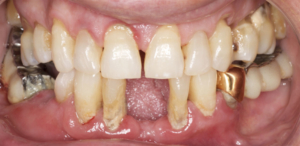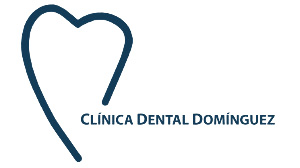Periodontics is the specialty that studies the prevention, the diagnosis and the treatment of the problems affecting the tissues and structures surrounding teeth.
1. By means of periodontal interventions it is possible to modify gums and bone to improve aesthetics, gain tooth support, and improve the health of certain areas.
2. Also, the treatment of periodontitis, (the disease more strongly associated with the loss of tooth support), is one of the most important fields this specialty tackles.
1. Periodontal interventions
There are many different periodontal interventions, such as:
Root coverage
The aim is to recover the lost gums. Note the before and after situation:

Crown lengthening
The aim is to expose the hidden part of teeth. Note the situation before, and right after surgery:

2. Treatment of periodontitis
What is periodontitis?
- Periodontitis is an infectious disease characterized by an irreversible destruction of the tissue that surrounds teeth. Although periodontitis cannot be eliminated, its course can be stabilized with an adequate treatment and periodontal maintenance.
Causas de la periodontitis
- Bacteria: the main cause of periodontitis. When tooth brushing is not adequate, bacteria are not eliminated and grow towards the gums and bone.
- Tobacco: it aggravates disease and worsens the treatment outcome
- Genetics and other disease (autoimmune disease, diabetes and obesity)
Consequences of periodontitis 
![]()
![]()
![]()
- The destruction of the tooth support can lead to tooth migration, tooth mobility and, finally, tooth loss.
- Inflammation resulting from periodontitis extends to the whole body, increasing the risk of developing and worsening disease, such as diabetes and cardiovascular disease. Also, it can affect pregnancy, being able to affect both the mother and the baby.
Treatment of periodontitis
- First, it is extremely important to improve tooth brushing, interdental hygiene and avoid toxic habits
- In the dental cabinet, scalig and root planning will be performed to eliminate bacteria strongly adhered to the root
- One month after scaling and root planing tissue health and, the risk of losing further bone will be assessed. The patient will either need adicional treatment, or start periodontal maintenance.
Maintenance programe
- It is important to understand that periodontitis can be stabilised, but will not disappear after treatment.
- Periodontal maintenance consists on controlling the gingival status, performing a profilaxis, and debriding those sites that still present inflammation.

- The frequency of periodontal maintenance visits range between 3 and 12 months. It will depend on the risk of the patient to present further disease progression. Such risk is determined by several parameters, such as the depth of the gums around teeth, presence of plaque (bacteria) and the presence of blood and pus.





